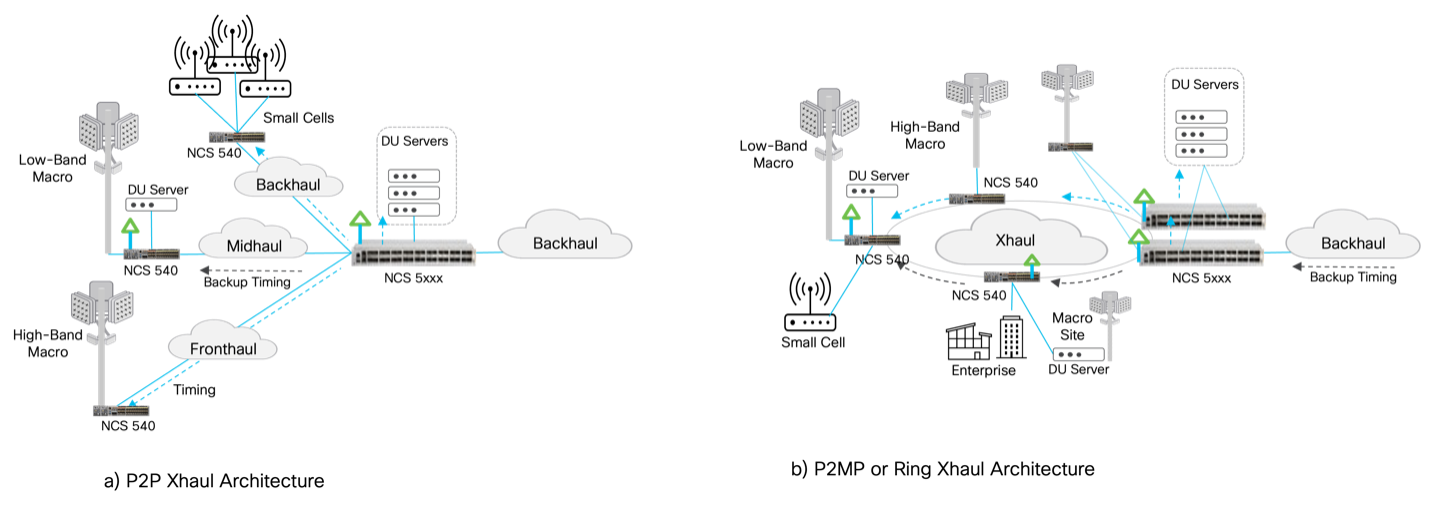Communication service providers (CSPs) are being challenged to deploy 5G in dense urban and high traffic environments while trying to optimize for cost and simplify capacity expansions. Centralized radio access network (CRAN) architectures are becoming critical as CSPs adopt mid-band and high-band spectrums to address 5G opportunities. CRAN architecture lowers capital expenditures (CapEx), simplifies operations, and enhances RAN performance with spectrum sharing technologies. CSPs need to look at their existing transport architecture to ensure that they realize these benefits by adopting CRAN.
Evolving the transport network is a first important step in adopting 5G on an existing 4G RAN network. The decision to either stay with distributed RAN (DRAN) architecture by expanding backhaul capacity or migrating to CRAN architecture with fronthaul investment is something every CSP must consider.
Cisco’s Converged SDN Transport architecture and product innovations are addressing these challenges with a unified transport architecture design. This way CSPs can adopt any deployment scenarios (CRAN, DRAN, or both) without changing the underlying transport protocols, management, and infrastructure services definition.
5G CRAN explained
4G is traditionally deployed with DRAN architecture, where radio baseband processing for each site is done locally (figure 1a). In CRAN, a large part of the radio baseband processing is done at a hub for multiple radio sites (figure 1b). In DRAN architecture, the RAN transport toward the mobile core is referred to as backhaul. In CRAN the transport network between the radio antenna and baseband processing units is referred to as fronthaul. Fronthaul has much more stringent latency, jitter, and synchronization requirements compared to backhaul.

There are several benefits with CRAN architecture, such as:
- Cost optimization: CRAN improves hardware utilization with centralized processing for multiple radio sites. It also reduces radio site footprint and optimizes power and cooling requirements.
- Spectrum gains: By processing multiple radio sites from a centralized hub location, it’s easier to process related functions like coordinated multipoint reception to remove inter-signal interference and implement carrier-aggregation techniques.
- Expansion and scale: CRAN simplifies capacity expansion, site acquisition, and deployment of heterogeneous networks to meet different business needs.
The benefits of CRAN are realized in dense urban and high traffic scenarios whereas DRAN is often more appropriate for rural and moderate traffic scenarios. CSPs need to consider their networks and traffic patterns in deciding between CRAN and DRAN adoption.
Building efficient RAN transport
CSPs are focused on building an xHaul transport architecture that allows them the flexibility to adopt DRAN or CRAN without worrying about the requirements of fronthaul, midhaul, or backhaul transport. They demand an architecture that meets the latency, jitter, and synchronization requirements of each of these transports – a flexible, programmable, and scalable 5G xHaul transport architecture.
As shown in figure 2, Cisco Converged SDN Transport, with Cisco NCS 540 and NCS 5700 series platforms, allows customers to build a 5G RAN transport that’s both scalable and flexible and can converge Layer 2 and Layer 3 services from the edge of the network. The architecture allows customers to offer various public and private 5G services covering eMBB, FWA, URLLC, and enterprise services.

Extending segment routing to the cell site not only simplifies the protocol stack and allows intelligent traffic steering, but also enables service slicing, programmability, and automation capabilities on the architecture. Fronthaul traffic, which is mostly Layer 2, can be carried over an EVPN slice with a low latency path while non-latency sensitive traffic can be carried over a L3VPN slice to meet 5G ORAN specifications. Built using timing best practices, the architecture allows adopting any access topology without impacting time synchronization accuracy.
Cisco’s Converged SDN Transport architecture simplifies adoption of DRAN and CRAN with a deployment that’s independent of network level protocols, infrastructure services, or synchronization architecture.
5G xHaul transport with NCS 540 and NCS 5700 series
Cisco NCS 540 and NCS 5700 series deliver performance, density, and exceptional efficiency to address transport pre-aggregation as well as 5G CRAN deployments. Powered by the IOS XR network operating system, the architecture focuses on simplified operations with programmability, manageability, and automation to meet key characteristics of 5G xHaul transport.

High Density Interfaces for 5G CRAN
NCS 5700 platforms offer high density 10G, 25G, 50G, 100G, and 400G interfaces to aggregate access transport links as well as 5G DU or CU servers at 5G CRAN or far-edge.
At cell sites, NCS 540 platforms offer high density 1G, 10G, and 25G interfaces to connect mid-band and high-band radios over CPRI or eCPRI interfaces with 100G or 400G options for uplink connections.
 Optical Support
Optical Support
Broad support of 400G and 100G QSFP-DD ZR/ZR+ optics across the NCS 540 and NCS 5700 portfolio enables CSPs to address bandwidth demand and scale through simplified network architecture.
 ORAN Characteristics
ORAN Characteristics
The NCS 540 and NCS 5700 portfolio meets 5G xHaul ORAN specifications to support fronthaul, midhaul, or backhaul deployments on a converged architecture.
With consistent performance that meets stringent microsec latency, accurate Class C timing and support of advanced segment routing features, EVPN, and integrated GNSS, the solution helps customers deploy any use case scenario under a single plane of management.
 Programmability and Automation
Programmability and Automation
Starting with segment routing v6 and microSIDs-based programmable routing, the solution offers zero-touch provisioning (ZTP) and advanced streaming telemetry as well as YANG model support.
Platforms support modern protocols like gRPC, gNMI, protobuf; and tools based on Chef, Puppet, and Ansible to help customers integrate management layers and simplify operations across access transport and 5G CRAN/far-edge. Network operations teams can take early action, achieve faster remediation, and ensure guaranteed service level agreements (SLAs) for a better end-user experience.

Very well explained Shahid.